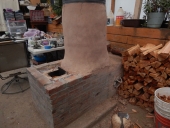





 1
1




 1
1




Success has a Thousand Fathers , Failure is an Orphan
LOOK AT THE " SIMILAR THREADS " BELOW !








John Elliott wrote:What does the main air filter look like? You could put a brand new one in and put a 1"x1" square of toilet paper (just one of the two-plys) right in the center of it, and that would be a decent air sampler for your house. After a couple of days of collection, you would have a sample that you could take to the laboratory and analyze. You can put that sample under the microscope and count for spores, pollen, fiberglass bits and "other". If you want to look specifically for fiberglass, you would have to digest the paper (in a chem lab they use nitric acid) and see what is left behind.
Once the wood stove is installed, you won't be forcing as much air through the vents, and it is the forced air that is carrying all the small particulate matter.
Ripping out insulation is a dirty task; and while you are ripping it out, a lot more of it is getting airborne. But if you hardly ever go under the house, then with the vents sealed off, there won't be a lot of it getting entrained into your household air.




allen lumley wrote:Ari Mattathias : Yes you are Overreacting a little,It is quite likely due to your location that mold or even Aerosolized rat shit Will cause you and your family harm !
When working with Fiberglass in any form it is a good idea to wear a simple paper type trash-able respirator, and coveralls taped at wrists and ankles ,after you
have finished work for the day those coveralls should be washed separately from other family members clothing, the machine should be run through its wash and
rinse cycle without any thing in the washer and your coveralls should be line dried !
Daily contact (breathing it in ) can over long exposure make your sick 5, !0, 20 years done the road, and thinking of your children future is always a good idea!
If you have leaking ductwork it should be sealed with a good grade of silver Duct tape, you should be able to plan on using your furnace for a back up "IF" ?!
I am going to suggest that you take one more trip into your Crawl Space, this time YOU are going to pull back the insulation in the pockets created by where your
Floor, Floor joists and Sill all meet at your outside wall. With a good flashlight, you are going to look at where your fiberglass insulation meets your sill and check
carefully for any present signs of trapped water vapor soaking into the insulation and or signs of past water staining on the wood or running down the inside of
your exterior walls.
Current code requires that instead of fiberglass insulation in these pockets, they should be filled up with a closed cell impermeable foam, the foundation you save
will be your own !
As a general rule I do not like U-Tube, but in this case, you should be able to find several good videos on protecting your crawl space from freeze ups, up-grading
your insulation and dealing with any moisture problems ! For the Good of the crafts ! BIG AL !
 1
1




 1
1




"If you want to save the environment, build a city worth living in." - Wendell Berry




"If you want to save the environment, build a city worth living in." - Wendell Berry
 1
1




"Think of your mind as a non-linear system that you constantly have to train"

|
I'm gonna make him a tiny ad he can't refuse!
Freaky Cheap Heat - 2 hour movie - HD streaming
https://permies.com/wiki/238453/Freaky-Cheap-Heat-hour-movie
|




